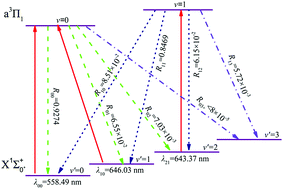Theoretical investigation on spin-forbidden cooling transitions of gallium hydride
Abstract
Herein, the spin-forbidden cooling of a gallium hydride molecule is investigated using ab initio quantum chemistry. The cooling transition and the corresponding potential energy curves including  , a3Π0−, a3Π0+, a3Π1, a3Π2, A1Π1,
, a3Π0−, a3Π0+, a3Π1, a3Π2, A1Π1,  , 13Σ+1,
, 13Σ+1,  ,
,  , and 23Σ+1 states are simulated based on the multi-reference configuration interaction approach plus Davidson corrections method. By solving the nuclear Schrödinger equation, we calculate the spectroscopic constants of these states, which are in good agreement with the available experimental values. Based on the transition data, there seems to be a theoretical puzzle: highly diagonally distributed Franck–Condon factor f00 for transitions
, and 23Σ+1 states are simulated based on the multi-reference configuration interaction approach plus Davidson corrections method. By solving the nuclear Schrödinger equation, we calculate the spectroscopic constants of these states, which are in good agreement with the available experimental values. Based on the transition data, there seems to be a theoretical puzzle: highly diagonally distributed Franck–Condon factor f00 for transitions  ,
,  , and
, and  for the gallium hydride molecule but the intervening state A1Π1 for
for the gallium hydride molecule but the intervening state A1Π1 for  transition is prohibitive to laser cooling. In addition, the
transition is prohibitive to laser cooling. In addition, the  transition does not have a suitable rate of optical cycling owing to a large radiative lifetime for
transition does not have a suitable rate of optical cycling owing to a large radiative lifetime for  state. Our theoretical simulation indicates the solution to the puzzle: the
state. Our theoretical simulation indicates the solution to the puzzle: the  transition has a high emission rate, and there is a suitable radiative lifetime for a3Π1 state, which can ensure rapid and efficient laser cooling of gallium hydride. The proposed laser drives
transition has a high emission rate, and there is a suitable radiative lifetime for a3Π1 state, which can ensure rapid and efficient laser cooling of gallium hydride. The proposed laser drives  transition by using three wavelengths (main pump laser λ00; two repumping lasers λ10 and λ21). These results demonstrate the possibility of laser-cooling the gallium hydride molecule, and a sub-microkelvin cool temperature can be reached for this molecule.
transition by using three wavelengths (main pump laser λ00; two repumping lasers λ10 and λ21). These results demonstrate the possibility of laser-cooling the gallium hydride molecule, and a sub-microkelvin cool temperature can be reached for this molecule.



 Please wait while we load your content...
Please wait while we load your content...